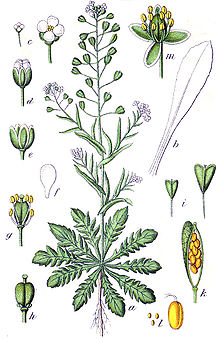Mother's heart
Capsella bursa-pastorisSummary 5
Capsella bursa-pastoris, known by its common name shepherd's-purse because of its triangular, purse-like pods, is a small (up to 0.5m) annual and ruderal species, and a member of the Brassicaceae or mustard family. It is native to eastern Europe and Asia minor but is naturalized and considered a common weed in many parts of the world, especially in colder climates, including Britain, where it is regarded as an archaeophyte,North America and China but also in the...
Capsella bursa pastoris 6
Description[edit]
C. bursa-pastoris plants grow from a rosette of lobed leaves at the base. From the base emerges a stem about 0.2 to 0.5 m tall, which bears a few pointed leaves which partly grasp the stem. The flowers are white and small, in loose racemes, and produce seed pods which are heart-shaped.[6]Like a number of other plants in several plant families, its seeds contain a substance known as mucilage, a condition known as myxospermy.[8] The adaptive value of myxospermy is unknown,[8] although the fact that mucilage becomes sticky when wet has led some to propose that C. bursa-pastoris traps insects which then provide nutrients to the seedling, which would make it protocarnivorous.[9]
Uses[edit]
C. bursa-pastoris is gathered from the wild[10] or grown[11] for food,[11][7] to supplement animal feed,[10] for cosmetics,[10] and for medicinal purposes.[7][10] It is commonly used as food in Shanghai and the surrounding Jiangnan region, where they are stir-fried with rice cakes and other ingredients or as part of the filling in wontons.[citation needed] It is one of the ingredients of the symbolic dish consumed in the Japanese spring-time festival, Nanakusa-no-sekku. In Korea it is known as naengi and its roots are one of the ingredients of the characteristic Korean dish, namul (fresh greens and wild vegetables).[12]Capsella bursa-pastoris herb has been used in the traditional Austrian medicine internally as tea or tincture, or externally as tincture, tea or ointments, for treatment of disorders of the skin, locomotor system, cardiovascular system, hemostasis, and gynaecologic problems.[13]Fumaric acid is one chemical substance that has been isolated from C. bursa-pastoris.[14]Parasites[edit]
Capsella bursa-pastorisSimplified Chinese荠菜Traditional Chinese薺菜TranscriptionsMandarinHanyu Pinyinjì càiWuRomanizationcie tshaeCantoneseJyutpingcai4 coi3- White rust Albugo candida
- One species of downy mildew Hyaloperonospora parasitica
References[edit]
- ^ abcAksoy A, Dixon JM and Hale WH (1998) Biological flora of the British Isles. Capsella bursa-pastoris (L.) Medikus (Thlaspi bursapastoris L., Bursa bursa-pastoris (L.) Shull, Bursa pastoris (L.) Weber). Journal of Ecology 86: 171-186
- ^"Capsella bursa-pastoris". Flora of Pakistan.
- ^ abPreston CD, Pearman DA & Dines TD (2002) New Atlas of the British Flora. Oxford University Press
- ^Preston CD, Pearman DA & Hall AR(2004) Archaeophytes in Britain. Botanical Journal of the Linnaean Society 145, 257-294
- ^USDA PLANTS Profile: Capsella bursa-pastoris (L.) Medik
- ^ abcBlanchan, Neltje (2005). Wild Flowers Worth Knowing. Project Gutenberg Literary Archive Foundation.
- ^ abcd"Capsella bursa-pastoris". Flora of China.
- ^ abTamara L. Western, Debra J. Skinner, and George W. Haughn (February 2000). "Differentiation of Mucilage Secretory Cells of the Arabidopsis Seed Coat". Plant Physiology122 (2): 345–355. doi:10.1104/pp.122.2.345. PMC 58872. PMID 10677428.
- ^Barber, J.T. (1978). "Capsella bursa-pastoris seeds: Are they "carnivorous"?". Carnivorous Plant Newsletter7 (2): 39–42.
- ^ abcd"Capsella bursa-pastoris (Ecocrop code 4164)". ecocrop. Food and Agriculture Organization of the United Nations.
- ^ ab"Capsella bursa-pastoris - (L.)Medik.". Plants For A Future database report.
- ^Pratt, Keith L.; Richard Rutt, James Hoare (1999). Korea: a historical and cultural dictionary. Richmond, Surrey.: Curzon Press. pp. pp. 310–310. ISBN 0-7007-0464-7. Cite uses deprecated parameters (help)
- ^Vogl S, Picker P, Mihaly-Bison J, Fakhrudin N, Atanasov AG, Heiss EH,Wawrosch C, Reznicek G, Dirsch VM, Saukel J, Kopp B. Ethnopharmacological in vitro studies on Austria's folk medicine - An unexplored lore in vitro anti-inflammatory activities of 71 Austrian traditional herbal drugs. J Ethnopharmacol.2013 Jun13. doi:pii: S0378-8741(13)00410-8. 10.1016/j.jep.2013.06.007. [Epub ahead of print] PubMed PMID: 23770053. http://www.ncbi.nlm.nih.gov/pubmed/23770053
- ^Kuroda, K.; Akao, M.; Kanisawa, M.; Miyaki, K. (1976). "Inhibitory effect of Capsella bursa-pastoris extract on growth of Ehrlich solid tumor in mice". Cancer Research36 (6): 1900–1903. PMID 1268843.
See also[edit]
Sources and Credits
- (c) autan, some rights reserved (CC BY-NC-ND), http://www.flickr.com/photos/56119072@N00/367986056
- (c) 2008 Keir Morse, some rights reserved (CC BY-NC-SA), http://calphotos.berkeley.edu/cgi/img_query?seq_num=268995&one=T
- (c) "<a href=""http://www.pwrc.usgs.gov/WLI/"">USDA NRCS Wetland Science Institute</a>.", some rights reserved (CC BY-NC-SA), https://plants.usda.gov/gallery/large/cabu2_001_lvp.jpg
- (c) "<a href=""http://www.pwrc.usgs.gov/WLI/"">USDA NRCS Wetland Science Institute</a>.", some rights reserved (CC BY-NC-SA), https://plants.usda.gov/gallery/large/cabu2_002_lhp.jpg
- (c) Wikipedia, some rights reserved (CC BY-SA), http://en.wikipedia.org/wiki/Capsella_bursa-pastoris
- (c) Unknown, some rights reserved (CC BY-SA), http://eol.org/data_objects/27559704
More Info
- iNat taxon page
- African Plants - a photo guide
- Atlas of Living Australia
- Biodiversity Heritage Library
- BOLD Systems BIN search
- Calflora
- CalPhotos
- Catalogo de Plantas y Líquenes de Colombia
- eFloras.org
- Flora Digital de Portugal
- Flora of North America (beta)
- Global Biodiversity Information Facility (GBIF)
- Go Botany
- HOSTS - a Database of the World's Lepidopteran Hostplants
- IPNI (with links to POWO, WFO, and BHL)
- Jepson eFlora
- Maryland Biodiversity Project
- NatureServe Explorer 2.0
- NBN Atlas
- New Zealand Plant Conservation Network
- OregonFlora.org
- SEINet Symbiota portals
- Tropicos
- USDA PLANTS database
- VASCAN by Canadensys
- World Flora Online
- 日本のレッドデータ検索システム
- 植物和名−学名インデックス YList
Range Map
iNat Map
| Color | white |
|---|










